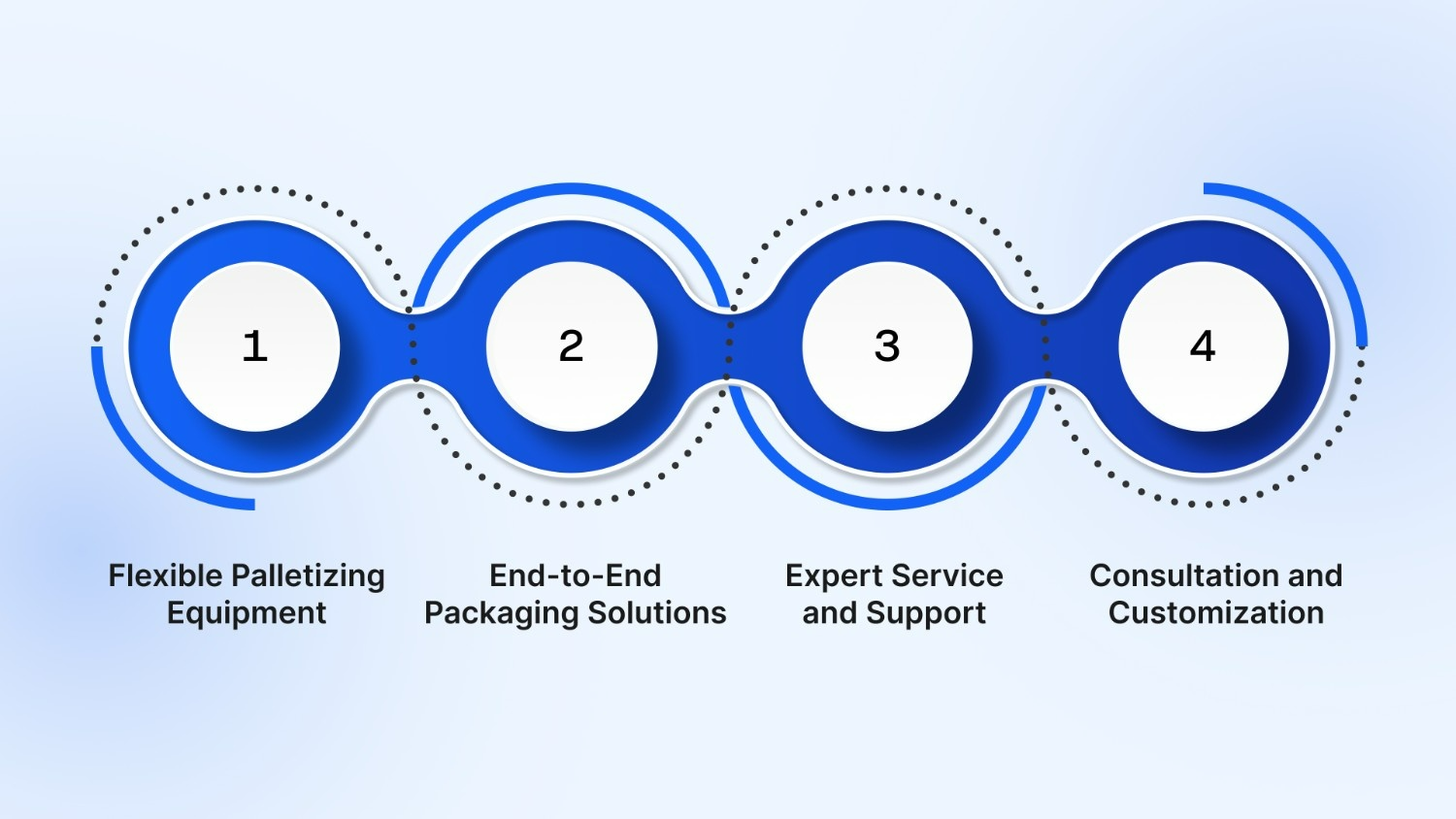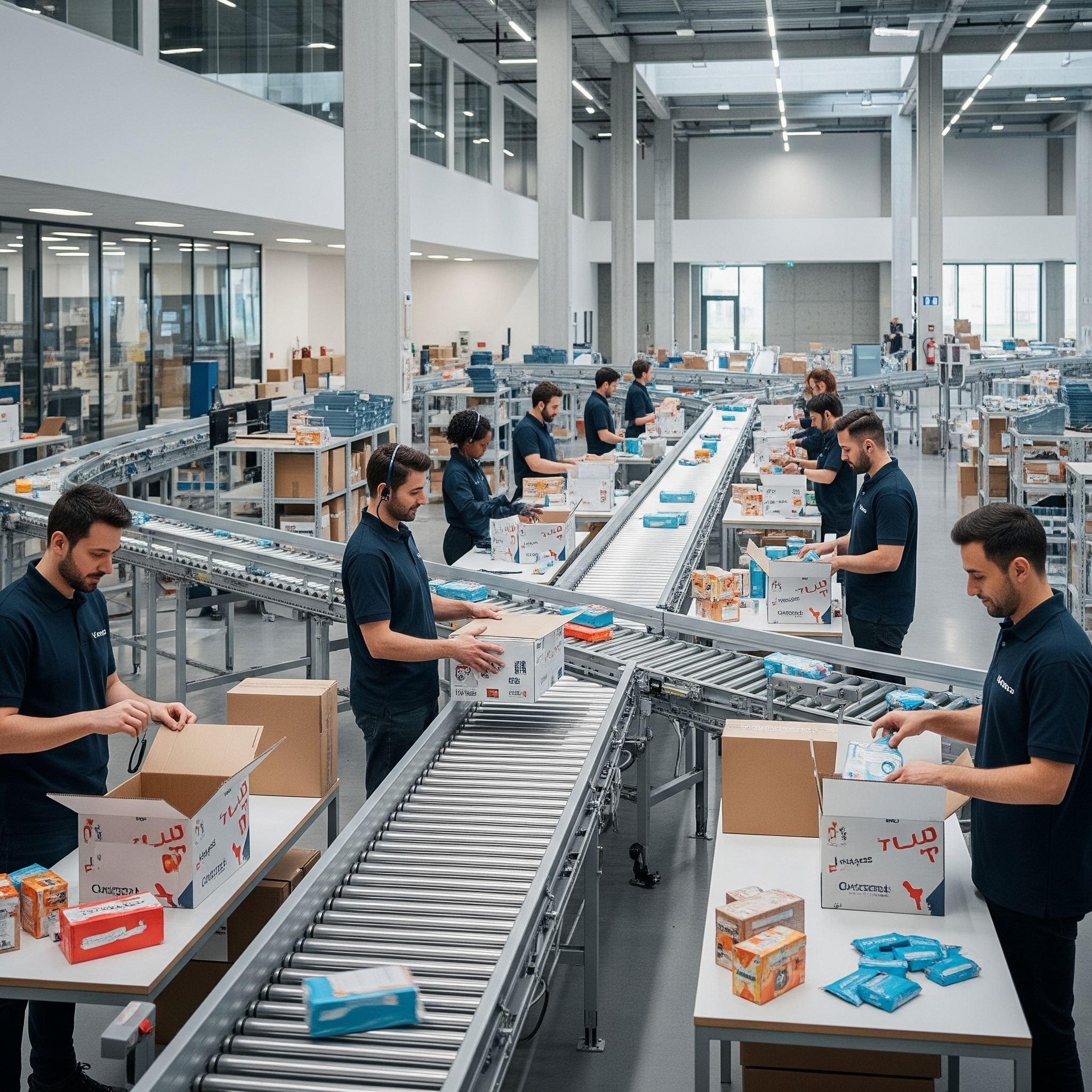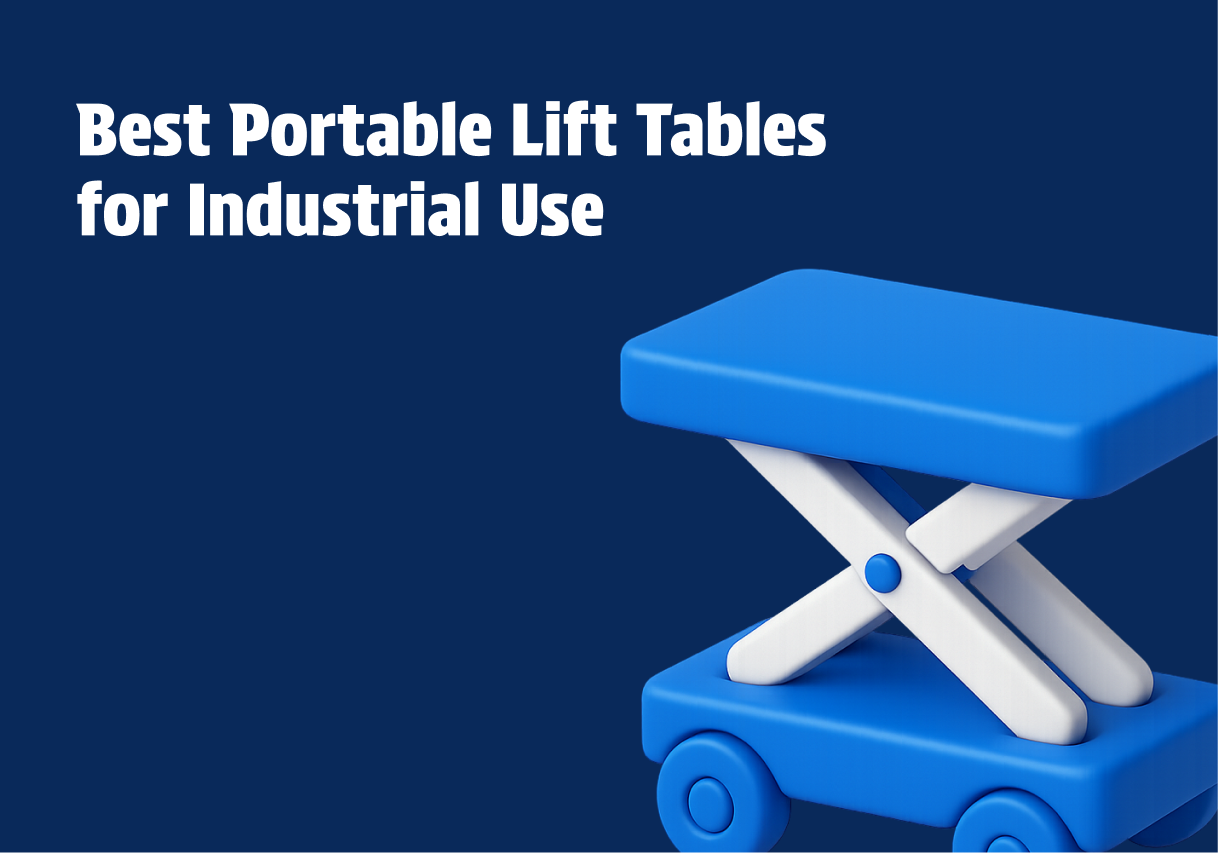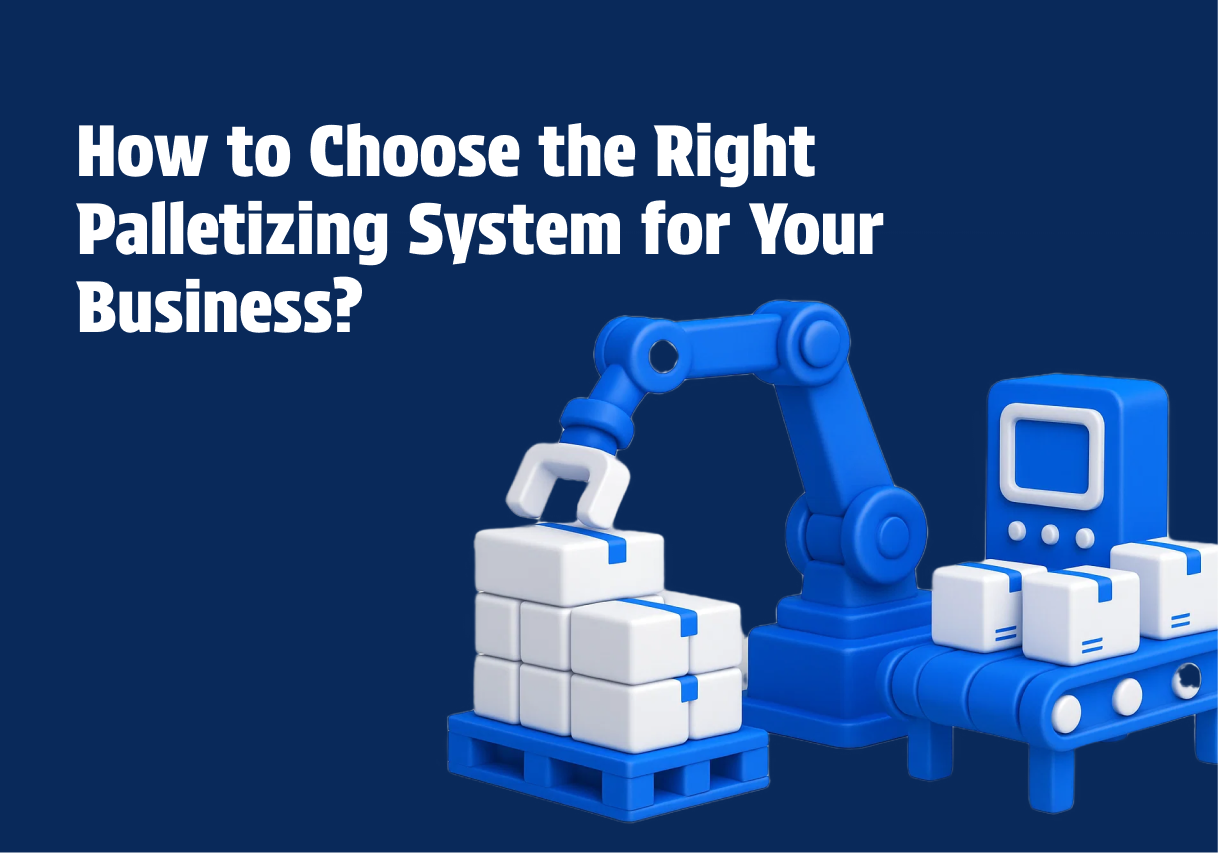In today’s fast-paced manufacturing and distribution environment, efficiency isn’t optional — it’s survival. Labor shortages, rising shipping volumes, and customer demands for faster delivery have made palletizing one of the most critical steps in packaging and logistics. The wrong palletizing setup can slow down your entire line, increase costs, and even create safety risks.
The good news? With the right system, you can increase throughput, improve load stability, and reduce labor costs. This guide breaks down how to choose a palletizing system that aligns with your products, space, and long-term business goals.
TL;DR (Key Takeaways)
- Match the system to your products → Size, weight, and packaging type directly impact palletizer choice.
- Design for your throughput → Calculate pallets/hour today and plan for growth.
- Consider space and automation levels → Robotic palletizers maximize flexibility in tight spaces, while conventional systems excel in high-speed, high-volume lines.
- Think ROI, not just upfront cost → Labor savings, uptime, and energy efficiency often outweigh initial investment.
- Partner with experts like John Maye Company → Equipment, leasing, installation, and support tailored to your industry.

Step 1: Define Your Product & Packaging Requirements
Before comparing palletizing systems, you need a clear understanding of what you’re palletizing.
- Product Dimensions → Are you stacking small cartons, oversized boxes, or irregularly shaped bags? Product size and shape will influence whether you need a conventional layer palletizer, a robotic arm, or a hybrid solution.
- Product Weight → Heavy items require systems with higher weight capacity and stronger pallet patterns to maintain stability.
- Packaging Type → Corrugated cartons, shrink-wrapped trays, open-top crates, or bundled products all interact differently with palletizers. Compatibility here ensures smooth stacking without jams or damage.
- Industry-Specific Considerations →
- Food & Beverage: Systems must often meet hygiene and washdown requirements.
- Pharmaceuticals: Precision and regulatory compliance are non-negotiable.
- E-commerce & Retail: SKU variety requires flexibility in handling mixed product sizes.
Tip: If your products vary widely, robotic palletizers with programmable grippers may offer the most long-term flexibility.
Step 2: Assess Production Speed and Throughput
A palletizing system that can’t keep up with your output will quickly become a bottleneck. Before making a decision, evaluate:
- Current Throughput → Calculate how many units or pallets you produce per hour/day.
- Peak Demand → Don’t just design for “average” volume; seasonal spikes or large orders can strain a system that isn’t built for flexibility.
- Multiple Lines → Do you need one palletizer serving several lines, or multiple dedicated systems?
- Future Growth → The best systems allow for scalability — modular upgrades, add-on robotic arms, or software updates that keep pace with your business.
Tip: If you’re running high-volume operations with predictable loads, conventional palletizers offer unmatched speed. For businesses with diverse product lines, robotic palletizers handle variation more efficiently, even if slightly slower per cycle.
Step 3: Evaluate Available Space & Layout
Not every facility can accommodate large-scale palletizing systems. Space planning is often the deciding factor between conventional and robotic options.
- Floor Space → Measure the installation footprint. Robotic palletizers typically require less floor space than conventional layer systems.
- Ceiling Height → Check for clearance. Tall stacking or robotic arms may require higher ceilings.
- Workflow Integration → Palletizers should fit into your existing material flow, whether you’re using conveyors, forklifts, or automated guided vehicles (AGVs).
- Accessibility → Ensure operators, technicians, and forklifts can access the system for maintenance and pallet movement.
Tip: In facilities where space is tight, consider compact robotic palletizing systems that offer maximum stacking flexibility without requiring major layout changes.
Step 4: Determine the Right Level of Automation
One of the most important decisions is whether your business needs manual, semi-automatic, or fully automated palletizing. Each option has trade-offs in speed, cost, and flexibility.
- Manual or Semi-Automatic Palletizers
- Best for small to mid-sized operations.
- Lower upfront cost but higher labor dependency.
- Useful for unique or irregular loads that require operator judgment.
- Conventional (Layer) Palletizers
- High-speed, consistent stacking for standard product sizes.
- Ideal for industries like beverage bottling or food manufacturing where throughput is critical.
- Less flexible when product types or packaging sizes frequently change.
- Robotic Palletizers
- Flexible and programmable, ideal for facilities handling multiple SKUs.
- Smaller footprint compared to traditional systems.
- Higher upfront cost, but lower long-term labor costs and greater versatility.
Tip: If your volumes are rising but product types remain stable, conventional palletizers are the best bet. If you anticipate product variety, robotic systems offer greater adaptability.
Step 5: Check System Compatibility & Load Stability
A palletizing system isn’t just about stacking boxes — it’s about delivering stable, shippable loads. Compatibility and stability checks are essential.
- Pallet Size → Most systems are built for standard 48” x 40” pallets, but if you use non-standard sizes, confirm compatibility.
- Stacking Patterns → Systems should support multiple patterns such as:
- Column stacking: Strong vertical support, but less interlocking stability.
- Interlocking (brick) stacking: Better stability during transport.
- Load Stability → Consider whether the palletizer integrates with pallet wrapping equipment or stretch film applicators to secure loads.
- Shipping & Handling Needs → Ensure the chosen system prevents shifting, crushing, or product damage during forklift handling and transit.
Tip: If you’re palletizing heavy or high-value goods, choose a system that pairs seamlessly with stretch wrapping or strapping equipment for maximum load protection.
Step 6: Analyze Maintenance, Service, and Support
Even the most advanced palletizing system is only as reliable as the support behind it. Downtime in palletizing quickly impacts the entire production line, so businesses should evaluate:
- Maintenance Schedules → Look for systems with clear maintenance intervals and accessible components. Preventive maintenance reduces breakdowns.
- Spare Parts Availability → Ensure the manufacturer or distributor can supply critical components quickly. Waiting days for replacement parts can halt production.
- Certified Technicians → Work with providers who have factory-certified installers and service teams. This guarantees correct setup and reduces troubleshooting errors.
- Training & Documentation → Operators and maintenance staff should receive hands-on training for safe, efficient use.
Tip: Partnering with a company like John Maye Company ensures you get not just the equipment, but long-term support — from installation to preventive maintenance programs.
Step 7: Review Cost and ROI Factors
Sticker shock is common with palletizing systems, but the real question isn’t “What does it cost?” — it’s “What does it save?”
- Upfront Cost vs. Long-Term Savings
- Automated systems reduce labor costs and errors.
- Savings often offset higher initial investment within a few years.
- Operating Costs
- Consider energy efficiency, film usage, and ongoing maintenance.
- Efficient systems reduce film waste and lower utility bills.
- Payback Period
- Many palletizing systems pay for themselves within 2–5 years depending on volume.
- Calculating ROI should factor in reduced downtime, fewer workplace injuries, and increased throughput.
Tip: When evaluating ROI, don’t forget to consider “soft savings” like improved worker safety, reduced product damage, and faster customer fulfillment.
Step 8: Industry-Specific Considerations
Every industry has unique palletizing requirements. Choosing the wrong system can create compliance risks, product damage, or operational inefficiencies.
- Food & Beverage → High throughput, hygiene standards, and washdown-capable equipment are essential. Conventional palletizers excel in bottling and canned goods due to speed, but robotic palletizers provide flexibility for mixed SKUs.
- E-commerce & Retail → Order profiles change constantly, requiring palletizers that adapt to multiple carton sizes. Robotic systems with programmable patterns are ideal.
- Pharmaceuticals & Healthcare → Accuracy and regulatory compliance take priority. Palletizers must ensure precise, contamination-free stacking.
- Heavy Manufacturing (Steel, Chemicals, Building Materials) → Durability and high load capacity are crucial. Look for rugged palletizers integrated with strapping and banding equipment for stability.
Match your palletizing solution not only to your products, but also to your industry regulations and safety requirements.
How John Maye Company Helps You Choose the Right Palletizing System

At John Maye Company, we understand that choosing a palletizing system is about more than equipment — it’s about building efficiency, reducing costs, and ensuring operational reliability. Here’s how we support your operations:
- Flexible Palletizing Equipment
- A wide range of pallet wrapping and palletizing systems designed for everything from small warehouses to high-volume manufacturing.
- Options to buy, rent, or lease depending on your budget and seasonal demand.
- End-to-End Packaging Solutions
- Integration with conveyors, shrink wrap equipment, and strapping systems to create a seamless packaging line.
- Supplies such as stretch films and tapes for ongoing needs.
- Expert Service and Support
- Equipment servicing from manufacturer-trained technicians.
- Preventive maintenance programs to minimize downtime.
- 24-hour shipping on parts and supplies to keep operations running.
- Consultation and Customization
- With 40+ years of expertise, we tailor solutions to specific industries like food, pharmaceuticals, e-commerce, and heavy manufacturing.
- Our team ensures your system is future-ready, scalable, and compliant with safety standards.
Choosing the right palletizing system doesn’t have to be overwhelming. John Maye Company brings the expertise, products, and support to make the decision clear and cost-effective.
Conclusion
The best palletizing system isn’t always the most expensive or the fastest — it’s the one that fits your products, throughput, facility, and long-term goals. By following a structured process — analyzing product needs, production speed, space, automation level, system compatibility, and ROI — you’ll make a choice that delivers stability, safety, and efficiency across your packaging line.
Investing in the right palletizing solution means fewer labor challenges, reduced product damage, and smoother shipping operations. And with a trusted partner, the process becomes easier, faster, and more reliable.
Ready to optimize your palletizing operations? Contact John Maye Company today. Our experts will help you choose, install, and maintain the right palletizing system tailored to your business.
Frequently Asked Questions (FAQs)
1. What’s the difference between robotic and conventional palletizers?
Robotic palletizers use arms with programmable grippers, offering flexibility for multiple SKUs and varied product sizes. Conventional (layer) palletizers specialize in high-speed, uniform loads — perfect for industries with consistent product packaging.
2. How much does a palletizing system cost?
Costs vary widely depending on automation level and system complexity. Semi-automatic palletizers may start in the tens of thousands, while high-speed robotic systems can reach several hundred thousand. However, ROI is often achieved within 2–5 years through labor and efficiency savings.
3. How do I calculate the ROI of a palletizing system?
Factor in reduced labor costs, fewer workplace injuries, less product damage, and higher throughput. Many companies see payback within a few years as efficiency gains offset the initial investment.
4. Can small businesses benefit from palletizing systems?
Yes. Semi-automatic and compact robotic systems make palletizing accessible for smaller operations, improving safety and reducing manual handling strain.
5. What industries benefit most from robotic palletizing?
Robotic palletizers are particularly valuable in e-commerce, retail, and pharmaceuticals where SKU variety and precision are critical. They also work well in food and beverage operations that require flexibility.

Blogs

Best Benefits of Renting Packaging Equipment vs. Buying Equipment
Discover the best benefits of renting packaging equipment vs. buying. Enjoy flexibility, reduced risks, and access to new tech. Click to see more!

Best Portable Lift Tables for Industrial Use
Explore the best portable lift tables for small operations. Discover ergonomic benefits, compact design, and efficiency. Boost safety and performance now!

Standard Pallet Loading Height and Dimensions Guide
Learn pallet loading height standards to prevent load collapse, cut downtime, and keep your industrial packaging operations running efficiently.
